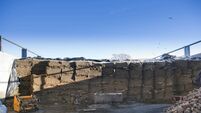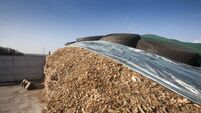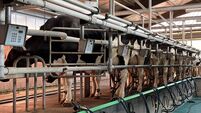Brian Reidy: Don't let poor pit covers spoil your silage investment

With grass silage costing as much as €250/t of dry matter to produce, no farm can afford to make mistakes when making, harvesting or clamping the crop.
If you have ticked all of the boxes in an effort to make good quality grass silage, it is critical that you don’t drop the ball when it comes to the final step of covering the pit.
All first cuts that I know of are ensiled at this stage, and it is worth inspecting pits at this stage to make sure the job was done right. With second and third cuts along with whole crops and maize still to be harvested this year, it is worth taking a closer look at the ensiling process in the yard.
With grass silage costing as much as €250/t of dry matter to produce, no farm can afford to make mistakes when making, harvesting or clamping the crop.
How silage is covered and what materials are used have a huge influence on your silage quality and stability. Silage fermentation and preservation rely on creating an oxygen-free environment for bacteria to do their job.
The presence of oxygen in a pit of silage results in the promotion of the wrong type of bacteria and a dramatic loss of dry matter and quality. The silage then becomes a poorer feed and significantly increases the cost of production on beef and dairy farms.
It is all too common for silage pits to be covered in a hurry, with the intention of coming back at a later date to tidy up the job. That rarely happens as we are all busy on the farm and the consequences of the rushed job are not seen until feeding out the silage commences.
The most effective way to cover a silage clamp is with a combination of high-quality silage sheeting, cling seal products, and plenty of weight on top of those.
Many now use the heavy canvas-type covers, which help to distribute weight better and have the added benefit of keeping birds off the plastic. This creates an airtight seal that minimises oxygen exposure, preventing silage waste and ensuring optimal preservation.
A durable and new, high-quality silage sheet should be used as a primary layer to cover the entire clamp. Many now sheet the side walls also and find it an excellent way of getting an even better airtight seal and also preventing water from penetrating the clamp.
Cling film-type products have also become more common in recent years. This is applied directly to the silage surface, under the heavier black plastic covers to form a tight seal and prevent air pockets.
Gravel bags, tires, or purpose-made mats should be used to weigh down the covers, ensuring a firm, airtight seal. Many have recently got contractors in to bolt tyres together and this speeds up covering and uncovering while also improving pit coverage.
Once the pit covering has been completed, it is a good idea, in the weeks after, to inspect the cover for any damage or wear and tear and repair as needed to maintain the seal. This may also include adjusting the position of tyres or gravel bags, particularly beside walls.
All the hard work of cutting good grass, ensiling it well and the effort of covering it can be undone by damage from birds and rodents. Keep bait down around the yard for rodents.
For birds, monitor the surface of the pit regularly and patch any holes. It may be necessary to use a net to keep them off the plastic. Any damage done to the top sheet will allow water and oxygen into the pit and increase spoilage/waste.
The canvas pit covers I mentioned above are an excellent way to keep birds off the pit.
Research has shown that poorly filled, consolidated and covered grass silage can result in between 10% and 30% dry matter losses. Overall losses (storage and feed out), can be reduced with improved silage-making practices, from the field to the pit and on to the feed barrier.
Silage is expensive, so getting to feed most of what you make should be a big priority on your farm.













